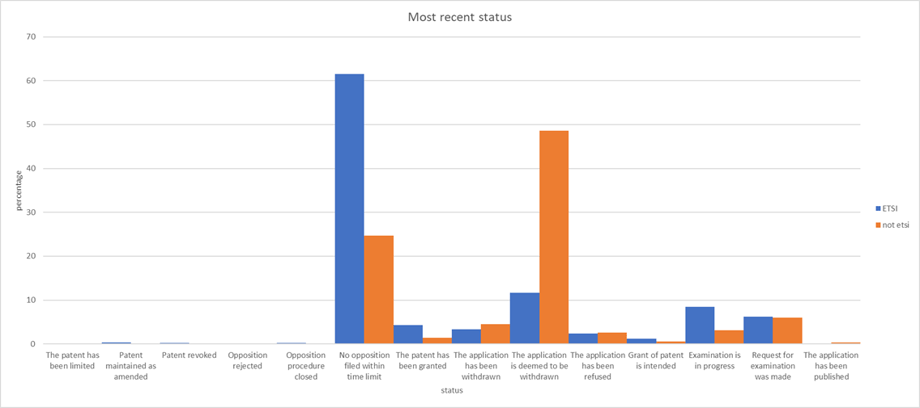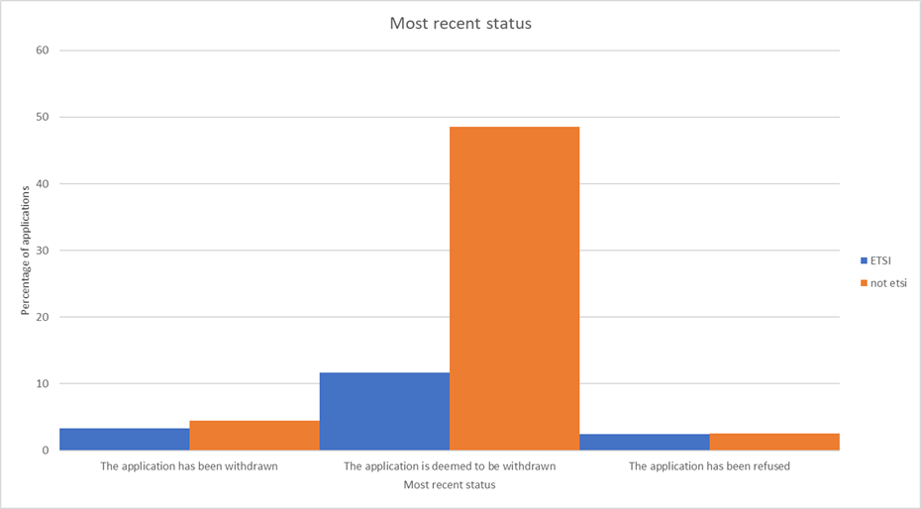
This article is the latest in a series of blogs exploring whether declaring your patent or application as “essential to a standard” influences the outcome of that patent or application in Europe.
We know from our previous articles (here and here) that an application declared to ETSI as standards essential is more than twice as likely to grant as compared to an application not declared to ETSI, and that applications declared as ETSI consistently receive more communications from the examination division than the other applications.
In this blog we are continuing to explore:
Do applicants behave differently during prosecution of a patent applications that were declared as ETSI vs applications that were not?
In our previous article we looked at how many office actions (i.e., examination reports) were received from the EPO for the ETSI and non-ETSI applications in our dataset.
For this blog we looked at what the most EPO recent status is for each application in our dataset. Using this data we can see whether ETSI-declared applications were more or less likely to be abandoned during prosecution, thus leading to more office actions.
The plot below shows the most recent status for every application in our dataset, including granted and pending applications.

The plot below specifically shows the percentage of applications which were “withdrawn”, “declared withdrawn”, or “refused” during prosecution.

It is clear from these plots that the not-ETSI applications have a much higher abandonment rate (i.e., they were more likely to be declared withdrawn) than the ETSI applications. This is consistent with the lower grant rate we have seen for the not-ETSI applications.
These plots show that the ETSI declared applications were more likely to be explicitly withdrawn by the applicant and slightly more likely than the not-ETSI applications to be refused by the examiner.
This appears to support the theory that applicants are more likely to “try harder” to get their application granted and are less likely to abandon the application if it has been declared as ETSI. For example, this may be because ETSI-declared patents are likely to have more value than non- ETSI patents. Additionally, given the assumption of infringement for ETSI-declared patents, the applicant may be more likely to accept a narrower claim scope and so are more likely to respond to office actions and amend the claims than they are to abandon the application.
What’s to come?
In subsequent blog posts we intend to investigate post-grant behaviour of SEPs vs not-SEPs, for example are SEPs more likely to be opposed? Who tends to oppose whom? And, how does the outcome of opposed SEPs compare to not-SEPs?
Please get in touch if you have a question that you think our data can answer!
About the authors
This blog was co-written by Tom Furnival and Rebecca Frith.
.png?width=105&height=105&name=headshot%20frame%20Hojae%20Lee-1%20(3).png)
Rebecca Frith
Rebecca is a trainee patent attorney working in our engineering team. Rebecca's expertise focuses on analogue and digital electronics, radar technology, secure hardware, particularly physically unclonable functions, radio and communications technology, software and firmware, machine learning and artificial intelligence, especially in relation to computer vision and privacy preserving applications
Tom is a Partner and Patent Attorney at Mewburn Ellis. He handles a wide range of patent work, including original drafting, prosecution and opposition, particularly defensive oppositions, in the engineering, electronics, computing and physics fields. Tom also advises on Freedom-to-Operate, infringement issues and registered designs.
Email: tom.furnival@mewburn.com
Sign up to our newsletter: Forward - news, insights and features
Our people
Our IP specialists work at all stage of the IP life cycle and provide strategic advice about patent, trade mark and registered designs, as well as any IP-related disputes and legal and commercial requirements.
Our peopleContact Us
We have an easily-accessible office in central London, as well as a number of regional offices throughout the UK and an office in Munich, Germany. We’d love to hear from you, so please get in touch.
Get in touch

